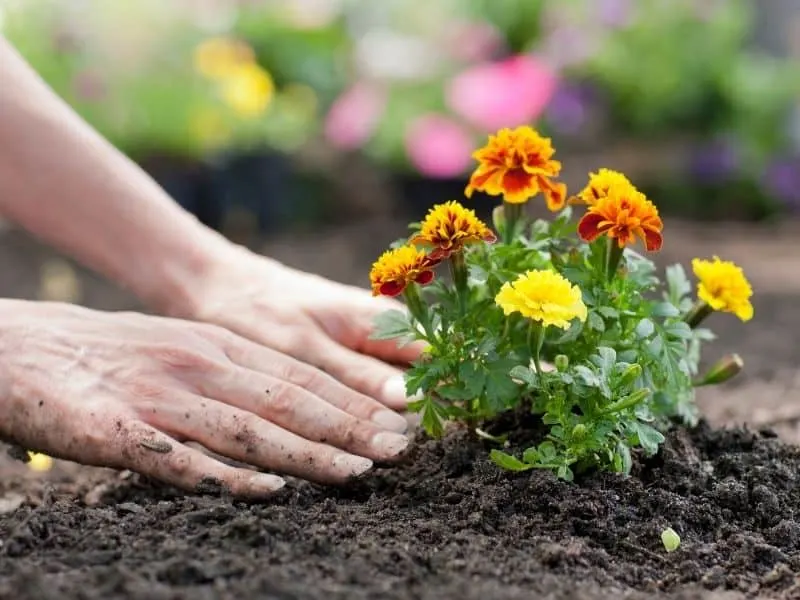Marigolds are a popular choice for gardeners and flower enthusiasts alike. This is largely due to their ease of growing and care. Marigolds are a great beginner flower and are also excellent companion plants in vegetable gardens. With their bright orange double blooms, marigolds add a great splash of color to any garden display. Here is how to grow marigolds from seed!

How To Grow Marigolds
The annual, colorful flower called the marigold is a staple in most gardens given its ease to grow. Marigolds germinate faster, which provides satisfaction for eager first-timers and children. There are also not a lot of special care instructions for marigolds, which is so nice, especially for beginners and even children.
Marigold varieties
There are around fifty species or varieties of marigolds, but here are the top 3 most common:
French Marigolds (Tagetes patula)
These are the most common marigolds found in plant nurseries; usually bright orange with underlying red petals
African Marigolds (Tagetes erecta)
The tallest variety of marigolds, African marigolds, also known as Mexican marigolds, Aztec marigolds, and American marigolds, are often lemon yellow or orange colored and look like pom-poms.
Signet Marigolds (Tagetes tenuifolia)
Signet marigolds have beautiful five-petal star-shaped flowers that are yellow or orange with bursts of color at the center.
Flowers often confused with marigolds
- Calendula: unrelated, but often called pot marigolds or English marigolds, they are used for medicinal purposes and have edible flowers
- Mexican Tarragon: related, but mainly used for culinary or medicinal purposes
- Mexican Marigold: related, but is an evergreen shrub
When to plant marigold seeds

Taller varieties like African Marigolds need to be planted in the early spring after all the frost has passed. This allows these taller varieties time throughout the season to grow and mature.
Smaller plants, like French marigolds and Signet marigolds, can be planted anytime from spring throughout the midsummer months. Given that marigolds germinate quickly, there is no need to panic plant the shorter varieties by a certain time.
How to prepare the planting site
Marigolds are not overly picky about their soil, but they do the best in moderately fertile and well-draining garden soil. It is important to plant marigolds in a place that gets full sun. However, some shade can be tolerated, especially in areas of high temperatures or heat waves.
Taller marigolds need to be protected from areas of strong winds, along with some structure to support them as they grow.
Given their quick germination time, there is no need to start the seeds inside and transplant them as the season starts. You can directly sow the seeds into the soil.
How to plant marigolds

It is key to wait until the danger of frost has passed and the fertile soil has warmed up. You can sow marigold seeds directly into the ground. Dig and loosen the soil no more than 1-inch deep and directly place seeds in the ground. You should space seeds, roughly an inch apart and cover lightly with soil. It is a good idea to water thoroughly after planting.
After sprouts have developed, it is important to thin out your marigolds. French and Signet varieties need to be spaced roughly 8 to 10 inches apart. African (and other taller) varieties need roughly 10 to 12 inches of space between plants. This allows for the plants to spread out and not become overcrowded.
If you didn’t get seeds and bought your marigold plants from your local nursery, wait until the last frost date and then plant them in your garden following the guide above for distance.
How long does it take marigold seeds to germinate
Marigolds germinate quickly, usually within a few days of being planted. Provided optimal conditions, you can expect to see sprouts rather quickly, in about a week.
How long does it take marigolds to grow
Depending on the variety, some marigolds need more time to grow to their full height. Standard marigolds (like French or Signet marigolds) only need a few weeks, whereas taller (like African) marigolds need more time and support to reach their full height. This is why it is recommended to plant taller varieties early in the season.
How long does it take marigold to bloom
Due to the speedy germination period, you can expect to see pretty flowers rather quickly as well. Marigolds bloom within 8 weeks from germination.
How to care for marigolds
First of all, last your marigolds where they’ll get at last 6 hours of sun if you want them to thrive. After sprouting, it is important to thin out your marigolds.
For those directly sown into the soil, you will need to space the marigold seedlings out 8 to 10 inches for shorter plants and 10 to 12 inches for taller plants as soon as the sprouts develop.
Marigolds in containers should be thinned out regularly as well. This can be done by taking a quality pair of scissors and gently cutting the seedlings out, being careful not to damage the roots of the remaining plants.
Make sure to water at the base of the plant, not overhead, and wait until the soil dries out before watering again.
It is also important to deadhead marigolds by pinching off dead or dying blooms down to the nearest healthy leaf. This can prevent root rot and powdery mildew from developing.
Wet conditions or overwatering can cause root rot or powdery mildew. Marigolds are also prone to attract leaf miners and spider mites. If affected, spray a solution of insecticidal soap over the plant every other day for two weeks.
How to harvest marigolds
To harvest marigolds, strip any leaves or foliage from the blossoms and hang them upside down to dry. By stripping the leaves, helps to eliminate the characteristically strong scent of marigolds.
To collect seeds from the seed pod, simply pluck the dried bloom from the stem.

When to harvest marigolds
To harvest the seed pods of marigolds, you should wait until the base of the bloom is turning brown. It is a good idea to be on the safe side of how much brown there is on the seed pod. If it is completely brown, it may have started to rot or mold.
Why you should grow marigolds
Marigold flowers make for a beautiful view when looking out at your garden and can provide a much-needed pop of color.
Marigolds also make great companion plants in your vegetable garden: they keep away harmful little insects, worms, and other critters like deer from eating in your garden.
On the other hand, marigolds produce lots of pollen that attracts beneficial insects (like bees and butterflies) and birds that are helpful in pollinating other plants.
FAQs about marigold plants
Do marigolds like sun or shade?
Sun! Like their beautiful and bright colors, marigolds love the sun and are full-sun flowers. So it is a good idea to have marigolds in an area that gets sun all day and where they will not be overshadowed by other plants.
What do marigolds keep away?
Marigolds are great companion plants to keep away some garden pests. Perhaps their most likable trait is that marigolds keep away mosquitoes. But marigolds also deter thrips, aphids, whiteflies, Mexican bean beetles, tomato hornworms, and nematodes.
Also, while deer and rabbits aren’t attracted to this plant, they are not foolproof against these animals.
Do marigolds come back every year?
Marigolds are annual flowers, meaning that they do not return every year. However, they often reseed themselves: and if not, it’s easy to plant anew next year.
Can some varieties take much longer than others?
Yes, some taller varieties need more time to reach their full potential. However, germination periods are pretty standard, so there is no difference between the varieties when you will start seeing sprouts. But in terms of reaching a height, yes, the taller varieties simply need more time.
It is recommended to plant taller versions early in the season after the last frost date to provide this time.
Why do marigold flowers turn black?
This is most likely due to powdery mildew, a fungus that attaches itself to dead or wet areas of the plant (you can prevent this by watering at the base, and not overhead) and slowly eats at the healthy areas of the plant.
Another reason marigolds turn black is their susceptibility to root rot, which is characterized by dark lesions at the soil line. The roots of the marigold are infected and the flower is not getting the nutrients it needs.
How long do marigolds bloom?
Marigolds bloom from late spring to the first frost, making them a beautiful summer flower that remains throughout the season! Depending on your climate, marigolds can stick around until early to mid-fall if they are still receiving proper sunlight and water.
How much water does a marigold need?
Marigolds are slightly picky about their watering habits, and too much moisture can cause root rot. You should let the soil dry in between watering. In times of high heat or dry weather, water regularly (once every day or two; feel the soil to gauge whether or not to water). Marigolds grown in containers should be watered daily as they tend to dry out quickly in containers.
Where do marigolds grow in vegetable gardens?
It is a good idea not to plant marigolds directly alongside, as this can impact the taste of your vegetables. However, you can plant them around the border or otherwise nearby. It is important to note that your marigolds may need different watering schedules than your vegetables, and you may need to water them separately.
Which vegetables benefit from marigolds?
Crops that benefit the best from marigolds include tomatoes, strawberries, cucumbers, snap beans, squash, onion, and garlic. These are the plants that are most impacted by nematodes that attack the roots of plants—and marigolds can prevent those nematodes.

Adriana Copaceanu is a passionate nature lover living in the country on her dream property where she grows vegetables, lavender, and wildflowers that she shares with the wildlife they attract. When she's not in the garden, she loves spending time with her chickens and planning her next nature project. Check out her books below:
How to Grow Lavender for Fun and Profit: Lessons Learned from Planting Three Hundred Lavender Plants




11 Great Companion Plants For Sunflowers (And 3 To Avoid)
Friday 30th of June 2023
[…] poster child of companion plants, marigolds pair with sunflowers as with most plants in the garden. These shorter, bushier annuals complement […]
7 Best Companion Plants For Eggplant (And 3 To Avoid)
Monday 24th of October 2022
[…] garden never feels complete until I get the bright, cheery marigolds planted (here’s how to grow marigolds). These ruffled, aromatic flowers attract parasitic wasps, ladybugs, pollinators, and other […]
11 Best Companion Plants For Corn (And 4 To Avoid)
Tuesday 6th of September 2022
[…] In addition to adding a lovely pop of bright color to the garden, marigolds deter a wide range of insect pests that plague the garden, such as aphids and Japanese beetles. These cheerful classic flowers deserve a spot (or several!) in every vegetable garden. Here’s how to grow marigolds. […]
12 Best Companion Plants For Cabbage (And 5 To Avoid)
Monday 16th of May 2022
[…] What vegetable garden is complete without marigolds? These bold, magical flowers repel numerous pests, including whiteflies, Japanese beetles, nematodes, and aphids. Additionally, marigolds attract parasitic wasps, ladybugs, hoverflies, and other beneficial insects. Here’s how to grow marigolds. […]
How To Keep Rabbits Out Of The Garden - 9 Easy Ways
Saturday 10th of July 2021
[…] them. However, this has not been proven as a fool-proof solution yet. If you want to try it out, plant a few marigolds around your perimeter fence or near any spots in your garden where you have had problems with […]